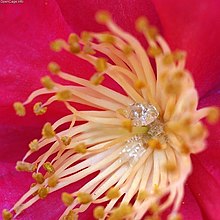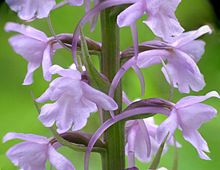Nectar




Nectar is a
Nectar is an economically important substance as it is the sugar source for honey. It is also useful in agriculture and horticulture because the adult stages of some predatory insects feed on nectar. For example, a number of predacious or parasitoid wasps (e.g., the social wasp species Apoica flavissima) rely on nectar as a primary food source. In turn, these wasps then hunt agricultural pest insects as food for their young. [1]
Nectar is most often associated with flowering plants
Etymology
Nectar is derived from
Floral nectaries
A nectary or nectarine is floral tissue found in different locations in the flower and is one of several secretory floral structures, including elaiophores and osmophores, producing nectar, oil and scent respectively. The function of these structures is to attract potential pollinators, which may include insects, including bees and moths, and vertebrates such as hummingbirds and bats. Nectaries can occur on any floral part, but they may also represent a modified part or a novel structure.[4] The different types of floral nectaries include:[5]
- receptacle (receptacular: extrastaminal, intrastaminal, interstaminal)
- hypanthium (hypanthial)
- tepals(perigonal, tepal)
- sepals(sepal)
- petal (petal, corolla)
- stamen (staminal, androecial: filament, anther, staminodal)
- pistil(gynoecial: stigmatic, stylar)
- pistillodes (pistillodal, carpellodial)
- ovaries (ovarian: non-septal, septal, gynopleural)
Most members of
Pollinators feed on the nectar and depending on the location of the nectary the pollinator assists in
Defense from
Floral nectaries have
Secretion
Nectar secretion increases as the flower is visited by pollinators. After pollination, the nectar is frequently reabsorbed into the plant.[16] The amount of nectar in flowers at any given time is variable due to many factors, including flower age,[17] plant location,[18] and habitat management.[19]
Extrafloral nectaries
Extrafloral nectaries (also known as extranuptial nectaries) are specialised nectar-secreting plant glands that develop outside of flowers and are not involved in
While their function is not always clear, and may be related to regulation of sugars, in most cases they appear to facilitate plant insect relationships.

Extrafloral nectaries have been reported in over 3941 species of

Foliar nectaries have also been observed in 101 species of
Components
The main ingredients in nectar are sugars in varying proportions of sucrose, glucose, and fructose.[28] In addition, nectars have diverse other phytochemicals serving to both attract pollinators and discourage predators.[29][7] Carbohydrates, amino acids, and volatiles function to attract some species, whereas alkaloids and polyphenols appear to provide a protective function.[29] The Nicotiana attenuata, a tobacco plant native to the US state of
Similar attractive substances
Some insect pollinated plants lack nectaries, but attract pollinators through other secretory structures. Elaiophores are similar to nectaries but are oil secreting. Osmophores are modified structural structures that produce volatile scents. In
See also
- Nectar guide
- Nectar source
- Nectarivore
- Northern American nectar sources for honey bees
References
- ^ "Killer Bees". www.columbia.edu. Retrieved 17 January 2022.
- PMID 23609022.
- ^ a b "Nectar". Online Etymology Dictionary, Douglas Harper. 2018. Retrieved 28 May 2018.
- ^ a b c d Rudall 2007, pp. 96–98.
- ^ Nicolson et al 2017, p. 41.
- ^ a b Willmer, Pat. Pollination and floral ecology. Princeton University Press, 2011.[page needed][ISBN missing]
- ^ a b c d Nicolson et al 2017.
- S2CID 85332036.
- .
- S2CID 11206264.
- S2CID 29016446.
- S2CID 19339791.
- .
- S2CID 20457047.
- JSTOR 3298546.
- ^ a b Thornburg 2001.
- ISSN 0044-8435.
- S2CID 41950102.
- S2CID 248300845.
- ^ a b c d Rudall 2007, pp. 66–68.
- ^ .
- ^ PMID 23087129.
- ^ Plant-Provided Food for Carnivorous Insects – Cambridge University Press
- ^ a b Sezen, Uzay. "Ants defending extrafloral nectaries of the passion flower (Passiflora incarnata)". Retrieved 6 January 2012.
- ^ Merbach, M. 2001. Nectaries in Nepenthes. In: C.M. Clarke Nepenthes of Sumatra and Peninsular Malaysia. Natural History Publications (Borneo), Kota Kinabalu.[page needed]
- ^ PMID 21490417.
- ^ Nectaries in ferns: their taxonomic distribution, structure, function, and sugar composition
- PMID 16373370.
- ^ PMID 19847105.
- ^ Everts, Sarah (1 September 2008). "Two-Faced Flowers". Chemical & Engineering News.
- ^ C.Michael Hogan (2008) Aesculus californica, Globaltwitcher.com, ed. N. Stromberg
- ^ Park & Thornburg 2009.
Bibliography
- Books
- Baker, H.G. and Baker, I. (1975) Studies of nectar-constitution and pollinator-plant coevolution. In Coevolution of animals and plants. Gilbert, L.E. and Raven, P.H. ed. Univ. of Texas Press, Austin, 100–140.
- Esau, K. (1977) Anatomy of seed plants. John Wiley & Sons, New York.
- Nicolson, Susan W.; Nepi, Massimo; Pacini, Ettore, eds. (2007). Nectaries and Nectar. Dordrecht: ISBN 978-1-4020-5937-7.
- Roshchina, V.V. and Roshchina, V.D. (1993) The excretory function of higher plants. Springer-Verlag, Berlin.
- ISBN 978-1-139-45948-8.
- Articles
- Baker, H.G.; Baker, I. (1973). "Amino acids in nectar and their evolutionary significance". Nature. 241 (5391): 543–545. S2CID 4298075.
- Baker, H.G. and Baker, I. (1981) Chemical constituents of nectar in relation to pollination mechanisms and phylogeny. In Biochemical aspects of evolutionary biology. 131–171.
- Beutler, R. (1935) Nectar. Bee World 24:106–116, 128–136, 156–162.
- Burquez, A.; Corbet, S.A. (1991). "Do flowers reabsorb nectar?". Funct. Ecol. 5 (3): 369–379. JSTOR 2389808.
- Carter, C.; Graham, R.; Thornburg, R.W. (1999). "Nectarin I is a novel, soluble germin-like protein expressed in the nectar of Nicotiana sp". Plant Mol. Biol. 41 (2): 207–216. S2CID 18327851.
- Deinzer, M.L.; Tomson, P.M.; Burgett, D.M.; Isaacson, D.L. (1977). "Pyrrolizidine alkaloids: Their occurrence in honey from tansy ragwort (Senecio jacobaea L.)". Science. 195 (4277): 497–499. PMID 835011.
- Ecroyd, C.E.; Franich, R.A.; Kroese, H.W.; Steward, D. (1995). "Volatile constituents of Dactylanthus taylorii flower nectar in relation to flower pollination and browsing by animals". Phytochemistry. 40 (5): 1387–1389. .
- Ferreres, Federico; Andrade, Paula; Gil, Maria I.; Tomás-Barberán, Francisco A. (1996). "Floral nectar phenolics as biochemical markers for the botanical origin of heather honey". Zeitschrift für Lebensmittel-Untersuchung und Forschung. 202 (1): 40–44. S2CID 84713582.
- Frey-Wyssling, A. (1955) The phloem supply to the nectaries. Acta Bot. Neerl. 4:358–369.
- Griebel, C.; Hess, G. (1940). "Der C-Vitamingehalt des Blütennektars bestimmter Labiaten". Zeitschrift für Untersuchung der Lebensmittel. 79 (1–2): 168–171. .
- Heinrich, G (1989). "Analysis of cations in nectars by means of a laser microprobe mass analyser (LAMMA)". Beitr. Biol. Pflanz. 64: 293–308.
- Heslop-Harrison, Y.; Knox, R.B. (1971). "A cytochemical study of the leaf-gland enzymes of insectivorus plants of the genusPinguicula". Planta. 96 (3): 183–211. S2CID 24535933.
- Jeiter, Julius; Hilger, Hartmut H; Smets, Erik F; Weigend, Maximilian (November 2017). "The relationship between nectaries and floral architecture: a case study in Geraniaceae and Hypseocharitaceae". PMID 28961907.
- Park, Sanggyu; Thornburg, Robert W. (27 January 2009). "Biochemistry of Nectar Proteins". Journal of Plant Biology. 52 (1): 27–34. S2CID 9157748.
- Peumans, W.J.; Smeets, K.; Van Nerum, K.; Van Leuven, F.; Van Damme, E.J.M. (1997). "Lectin and alliinase are the predominant proteins in nectar from leek (Allium porrum L.) flowers". Planta. 201 (3): 298–302. S2CID 28957910.
- Rodríguez-Arce, Angel L.; Díaz, Noemi (April 1992). "THE STABILITY OF β-CAROTENE IN MANGO NECTAR". The Journal of Agriculture of the University of Puerto Rico. 76 (2): 101–102. S2CID 247606388.
- Scala, J.; Iott, K.; Schwab, W.; Semersky, F.E. (1969). "Digestive secretion of Dionaea muscipula (Venus's-Flytrap)". Plant Physiol. 44 (3): 367–371. PMID 16657071.
- Smith, L.L.; Lanza, J.; Smith, G.C. (1990). "Amino acid concentrations in extrafloral nectar of Impatiens sultani increase after simulated herbivory". Ecol. Publ. Ecol. Soc. Am. 71 (1): 107–115. JSTOR 1940251.
- Vogel, S. (1969) Flowers offering fatty oil instead of nectar. Abstracts XIth Internatl. Bot. Congr. Seattle.
- Websites
- Thornburg, Robert (4 June 2001). "Nectar". Nectary Gene Expression Index. Department of Biochemistry, Biophysics and Molecular Biology,Iowa State University. Archived from the original on 10 September 2003. Retrieved 11 January 2020.


